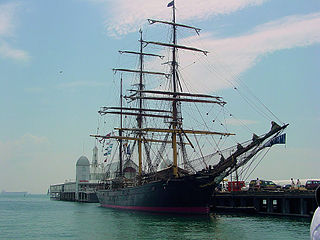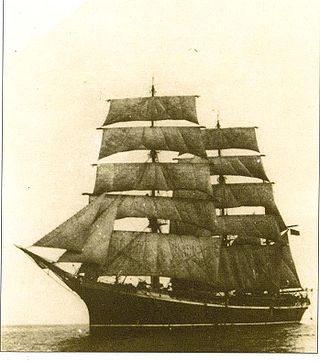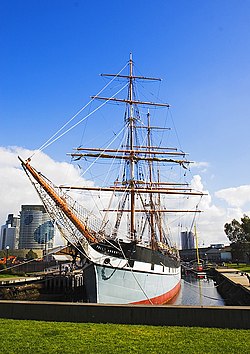Voyages 1904–1922
In 1904 Polly Woodside was sold to A.H. Turnbull of New Zealand and renamed Rona after Miss Rona Monro, daughter of a shareholder in the company. Valued in 1906 at £4,300, Rona then generally operated on the New Zealand–Australian run, carrying timber, salt, cement, grain and coal. The ship changed hands in 1911 for £3000 to Captain Harrison Douglas, [4] of New Zealand and again in 1916 to the George H. Scales Company. Because of the heavy loss of shipping in the 1914–1918 war, Rona also traded between New Zealand ports and San Francisco, carrying case oil and copra. [5] Two mishaps occurred in the last years of the ship's sailing career. In March 1920 the schooner W. J. Pirie, under tow in San Francisco harbour, collided with Rona at anchor, carrying away her headgear. Then in June 1921 the Rona, carrying a cargo of coal, grounded on Steeple Rock, off Wellington Heads. The shingle bottom caused little damage and she was able to be towed into Wellington harbour. However, some slight stress fractures to the hull plating could still be seen when the ship was dry-docked in 1974. [6]
Preservation and restoration since 1968
A number of half-hearted efforts were made in the mid 20th century to preserve Australia's sailing heritage, at the same time as it rapidly disappeared from Australian ports. In 1934, the Shiplover's Society of Victoria arranged for the coal hulk Shandon (a 1,400 ton former barque) to be partially re-rigged and refitted as a static display, to celebrate the centenary of European settlement. [11] However, by the early 1960s, Rona was the last of her kind still afloat in Australia. A few others lay full of water, abandoned and forgotten – the James Craig in Recherche Bay, Tasmania; the Santiago in the Port River, near Adelaide. The Polly Woodside's restoration owes much to the efforts of Karl Kortum, former director of the San Francisco Maritime Museum, who inspired Dr. Graeme Robertson of the National Trust of Australia (Victoria) to put up a proposal to save the ship in 1962. In the context of the time, this proposal was quite risky but showed extraordinary vision. [12] The National Trust of Australia relied entirely on volunteer labour, and it had no experience in restoring a sailing ship, even for static display. The restoration of the Rona/Polly Woodside would be a massive task. A long campaign led to the National Trust of Australia purchasing her from Howard Smith Industries for one cent in 1968.
An estimated 60,000 hours of painstaking voluntary labour saw the ship refurbished close to its original state. [13] [14] The project received strong support from businesses, unions, former crewmembers and several Captains. The first Master of Restoration, Captain G.H.Heyen was a master in sail. Polly Woodside's chief rigger for 27 years of restoration was Tor Lindqvist, a former able seaman and sailmaker on Lawhill, Passat and Viking. [15] In 1978 she was opened under her original name to the public, and is now permanently moored at the old Duke and Orr's Dry Dock on the Yarra River near Melbourne. Now landlocked by a nearby roadbridge, she cannot take to sea like the restored barque James Craig, of Sydney.
In 1988 the World Ship Trust awarded their seventh maritime heritage award to Polly Woodside, for "supreme achievement in the preservation of maritime heritage" – a first for a restored merchant ship. [16] In March 2007, Polly Woodside was added to the Victorian Heritage Register. [17] [18]

HMVS Cerberus is a breastwork monitor that served in the Victoria Naval Forces, the Commonwealth Naval Forces (CNF), and the Royal Australian Navy (RAN) between 1871 and 1924.

A hulk is a ship that is afloat, but incapable of going to sea. Hulk may be used to describe a ship that has been launched but not completed, an abandoned wreck or shell, or to refer to an old ship that has had its rigging or internal equipment removed, retaining only its buoyant qualities. The word hulk also may be used as a verb: a ship is "hulked" to convert it to a hulk. The verb was also applied to crews of Royal Navy ships in dock, who were sent to the receiving ship for accommodation, or "hulked". Hulks have a variety of uses such as housing, prisons, salvage pontoons, gambling sites, naval training, or cargo storage.

James Craig is a three-masted, iron-hulled barque restored and sailed by the Sydney Heritage Fleet, Sydney, Australia.

The Port of Melbourne is the largest port for containerised and general cargo in Australia. It is located in Melbourne, Victoria, and covers an area at the mouth of the Yarra River, downstream of Bolte Bridge, which is at the head of Port Phillip, as well as several piers on the bay itself. Since 1 July 2003, the Port of Melbourne has been managed by the Port of Melbourne Corporation, a statutory corporation created by the State of Victoria.

Sydney Heritage Fleet, is the trading name of Sydney Maritime Museum Ltd., a public company in Sydney, New South Wales, Australia.

Moshulu is a four-masted steel barque, built as Kurt by William Hamilton and Company at Port Glasgow in Scotland in 1904. The largest remaining original windjammer, she is currently a floating restaurant docked in Penn's Landing, Philadelphia, adjacent to the museum ships USS Olympia and USS Becuna.

Glenlee is a steel-hulled three-masted barque, built as a cargo ship at Port Glasgow under that name in 1896 for Glasgow owners. With later owners she was named Islamount and Clarastella. From 1922 she was the sail training ship Galatea in the Spanish Navy. Since 1993, carrying her original name, Glenlee has been a museum ship at the Riverside Museum on Pointhouse Quay, Glasgow, known as The Tall Ship at Glasgow Harbour.

Edwin Fox is one of the world's oldest surviving merchant sailing ships. The Edwin Fox is also the only surviving ship that transported convicts to Australia. She is unique in that she is the "only intact hull of a wooden deep water sailing ship built to British specifications surviving in the world outside the Falkland Islands". Edwin Fox carried settlers to both Australia and New Zealand and carried troops in the Crimean War. The ship is dry-docked at The Edwin Fox Maritime Centre at Picton in New Zealand.

Success was an Australian prison ship, built in 1840 at Natmoo, Burma, for Cockerell & Co. of Calcutta. Between the 1890s and the 1930s, she was converted into a floating museum displaying relics of the convict era and purporting to represent the horrors of penal transportation in Great Britain and the United States of America. After extensive world tours she was destroyed in 1946 by fire while berthed in Lake Erie near Cleveland, Ohio.

SS John Oxley is a steamship that previously served as a pilot boat and lighthouse and buoy tender. The ship was built in Scotland in 1927 for the Queensland Government. The vessel was requisitioned by Royal Australian Navy during the World War II. Returned to her duties after the war, John Oxley remained active until 1968, when her deteriorating condition made her unusable. In 1970, the ship was donated by the Queensland Government to the Lady Hopetoun and Port Jackson Marine Steam Museum for preservation, but due to other projects, work was sidelined until 2004. The ship has undergone restoration for the past 20 years at Rozelle Bay on a floating dock. In April 2022, she was towed to dry dock at Garden Island, re-floated successfully and returned to Rozelle Bay for further restoration work afloat.

HMS Nelson was a 126-gun first rate ship of the line of the Royal Navy, launched on 4 July 1814 at Woolwich Dockyard, but then laid up incomplete at Portsmouth until 1854, when work began with a view to commissioning her for service in the Crimean War, but this ended before much work had been done, and the ship returned to reserve.

Red Jacket was a clipper ship, one of the largest and fastest ever built. She was also the first ship of the White Star Line company. She was named after Sagoyewatha, a famous Seneca Indian chief, called "Red Jacket" by settlers. She was designed by Samuel Hartt Pook, built by George Thomas in Rockland, Maine, and launched in 1853, the last ship to be launched from this yard.

South Wharf is an inner-city suburb in Melbourne, Victoria, Australia, 2 km south-west of Melbourne's Central Business District, located within the City of Melbourne local government area. South Wharf recorded a population of 71 at the 2021 census.

Grain Race or The Great Grain Race was the informal name for the annual windjammer sailing season generally from South Australia's grain ports on Spencer Gulf to Lizard Point, Cornwall on the southwesternmost coast of the United Kingdom, or to specific ports. A good, fast passage Australia-to-England via Cape Horn was considered anything under 100 days.

South Brisbane Dry Dock is a heritage-listed dry dock at 412 Stanley Street, South Brisbane, City of Brisbane, Queensland, Australia. It was designed by William David Nisbet and built from 1876 to 1887. It is also known as the Government Graving Dock. It was added to the Queensland Heritage Register on 21 October 1992.
Herald of the Morning was a three-masted square-rigged sailing ship, built in 1853 or 1854 at Saint John, New Brunswick, Canada, expressly for the Australia run. The contemporary Melbourne press described her as 'a fine ship of 1292 tons register'

Hougomont was the name of a four-masted steel barque built in Greenock, Scotland in 1897 by Scotts Shipbuilding & Engineering Co. In 1924 she was purchased by Gustav Erikson's shipping company in Mariehamn, Åland, Finland. She was used for transport and schooling ship for young sailors until 1932 when a squall completely broke her rig on the Southern Ocean and she was sunk as breakwater near the town of Stenhouse Bay in South Australia. ' Hougomont had a crew of 24 men. The name "Hougomont" is derived from Château d'Hougoumont where the Battle of Waterloo was fought. While seaworthy she sailed to Peru, Florida, Canada, Australia, England, Ireland, and Sweden among other destinations. She had two sister ships, Nivelle and Archibald Russell.

Orient was a wooden-hulled, three-masted sailing ship that was built in England in 1853 and scrapped in Gibraltar in 1925. She served in the Crimean War, and then spent two decades with James Thompson & Co's "Orient Line" of ships sailing between Great Britain and South Australia.

Donald McKay was an extreme clipper designed by Donald McKay, his last. Built for James Baines & Co., she sailed on the Black Ball Line of Liverpool from 1855 to 1868, carrying passengers and mail between England and Australia.




















